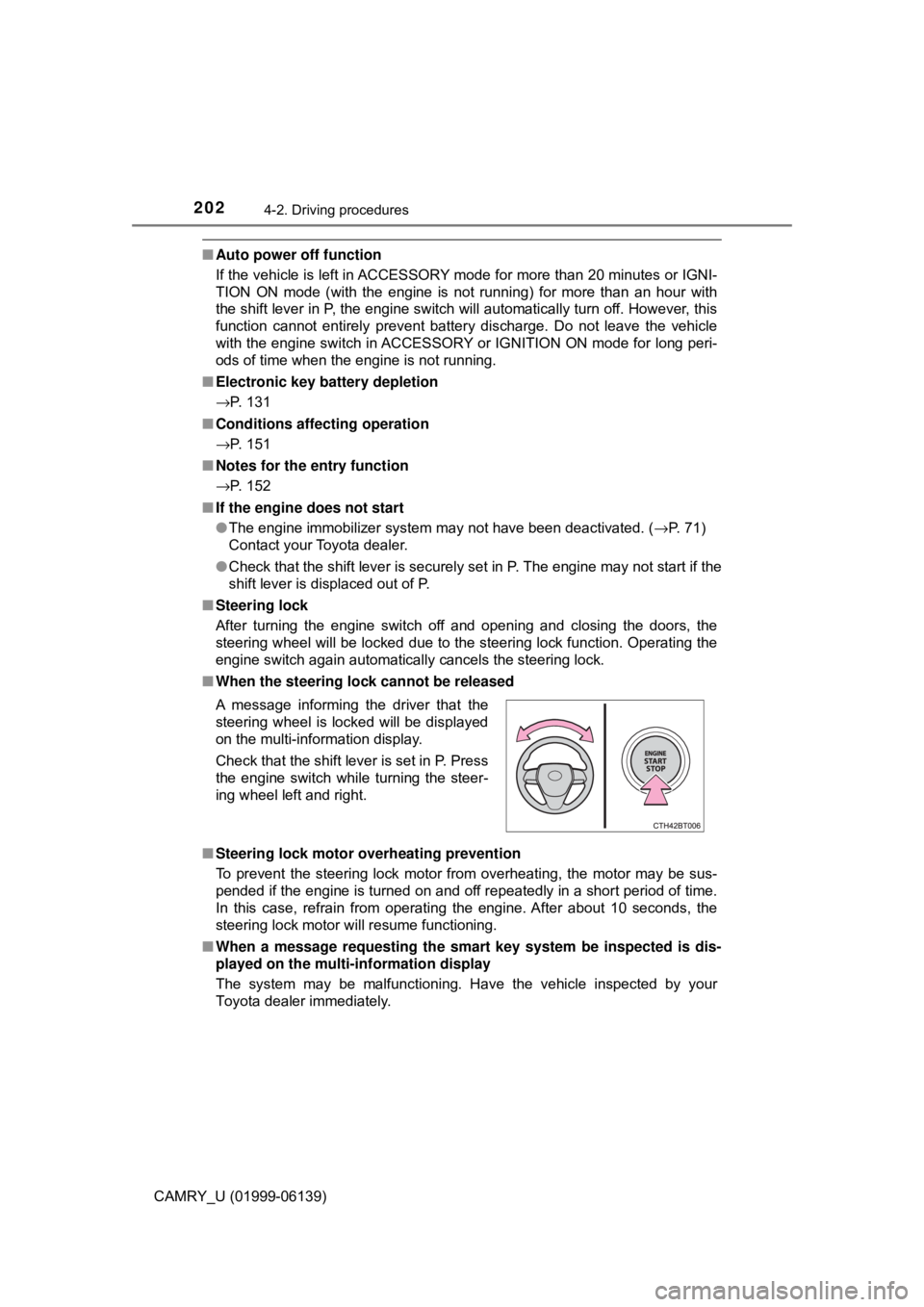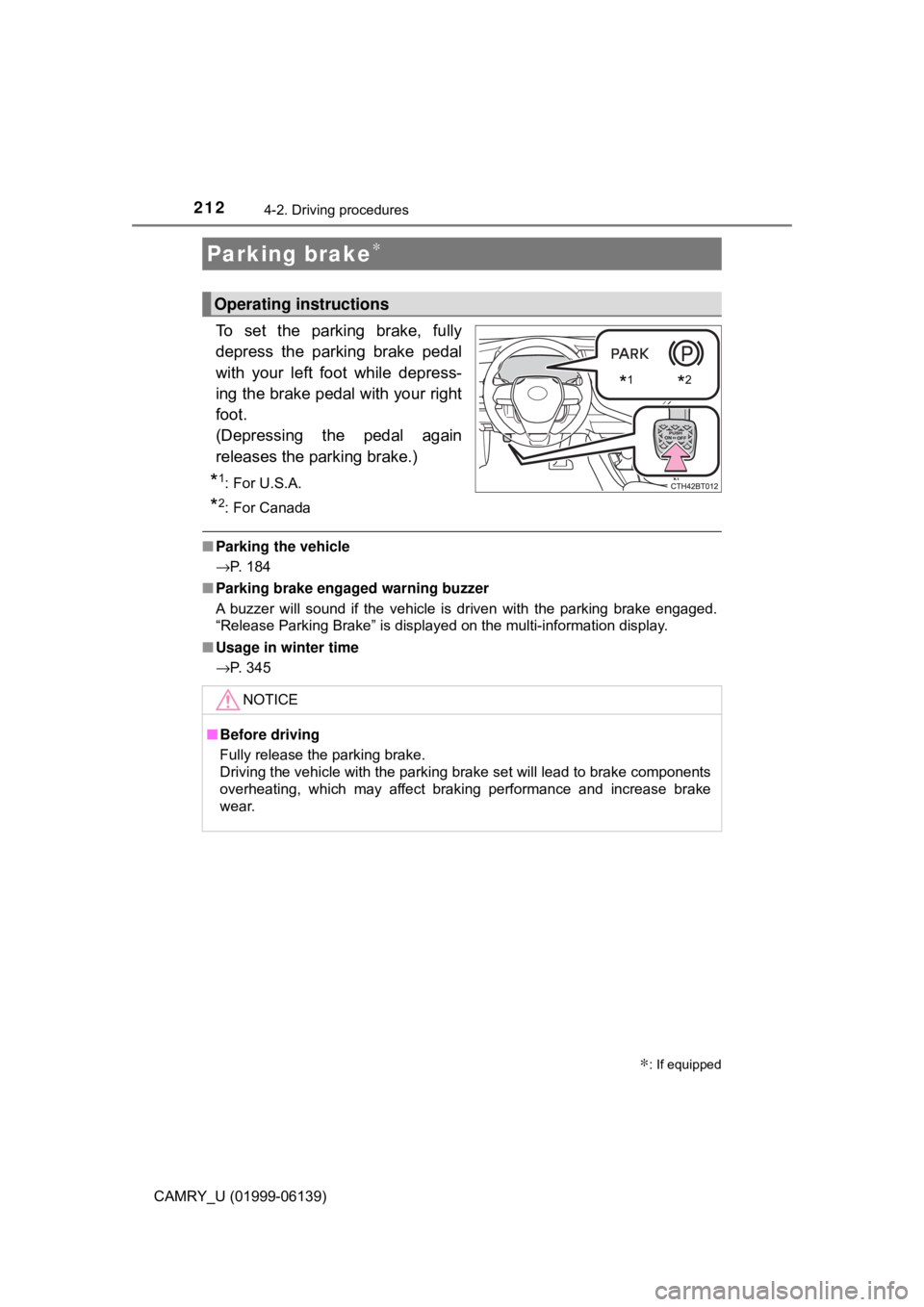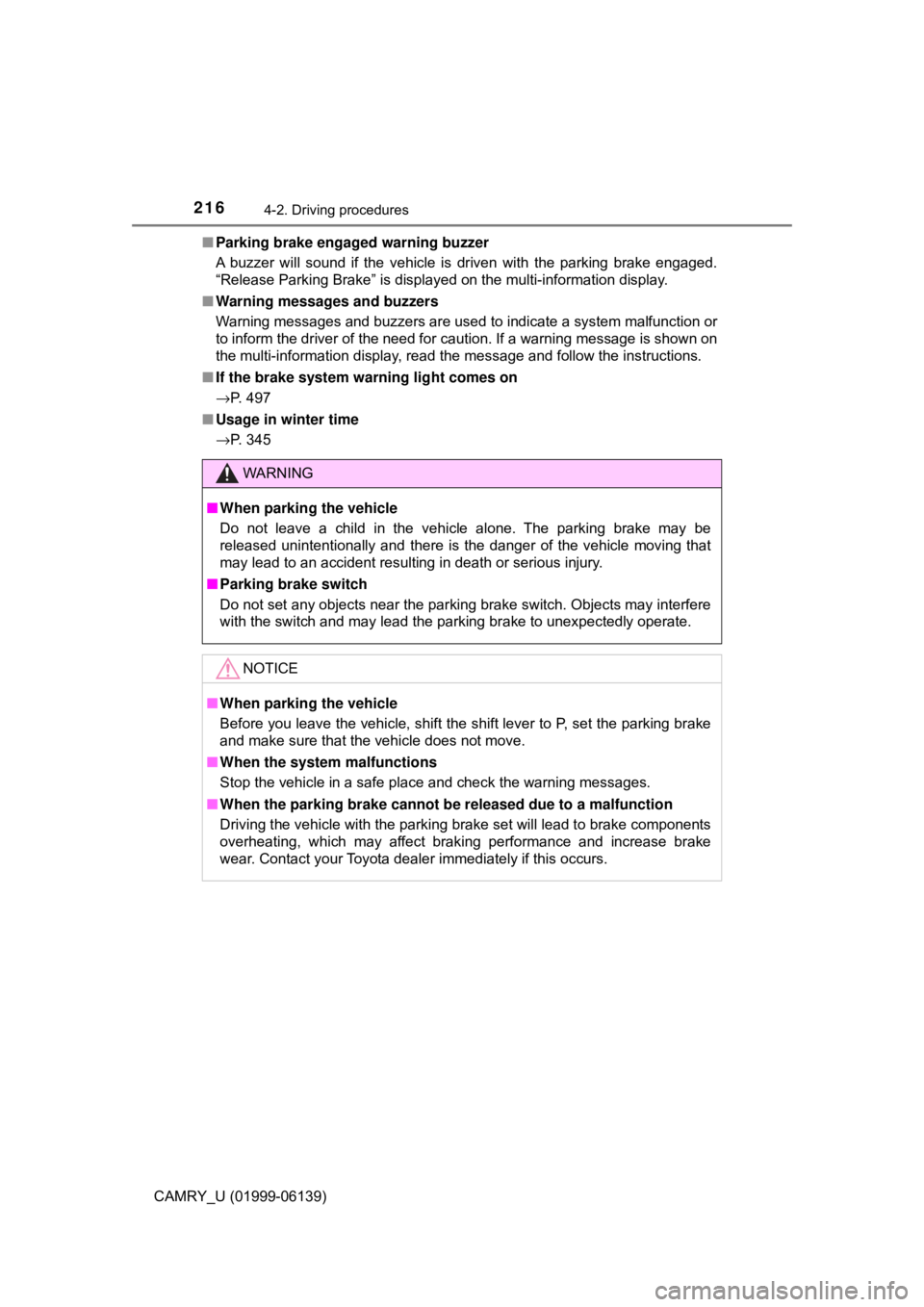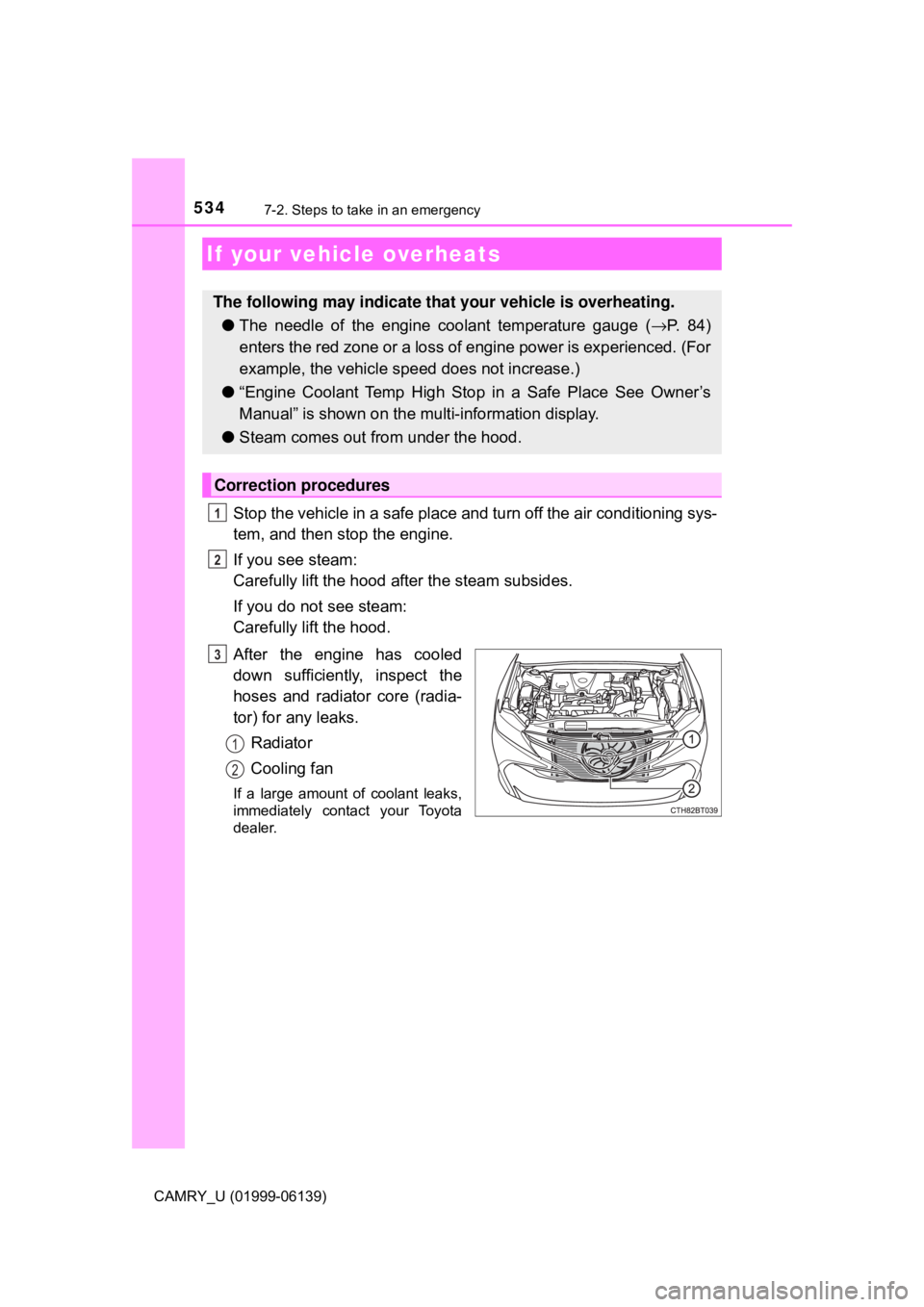overheating TOYOTA CAMRY 2018 Owners Manual (in English)
[x] Cancel search | Manufacturer: TOYOTA, Model Year: 2018, Model line: CAMRY, Model: TOYOTA CAMRY 2018Pages: 612, PDF Size: 10.63 MB
Page 86 of 612

862. Instrument cluster
CAMRY_U (01999-06139)
■The meters and display illuminate when
Vehicles without a smart key system
The engine switch is in the “ON” position.
Vehicles with a smart key system
The engine switch is in IGNITION ON mode.
■ Brightness of the meters (day mode and night mode)
●The brightness of the meters is changed between day mode and night
mode.
• Day mode: When the tail lights are off or when the tail lights are on but
the surrounding area is bright
• Night mode: When the tail lights are on and the surrounding area is dark
● When in night mode, the brightness will be reduced slightly unless the
meters are set to the maximum brightness level.
■ Outside temperature display
In the following situations, the correct outside temperature may not be \
dis-
played, or the display may take longer than normal to change:
●When stopped, or driving at low speeds (less than 16 mph [25 km/h])
● When the outside temperature has changed suddenly (at the entrance/exit
of a garage, tunnel, etc.)
● When “ − −” or “E” is displayed, the system may be malfunctioning.
Take your vehicle to your Toyota dealer.
NOTICE
■ To prevent damage to the engine and its components
● Do not let the indicator needle of the tachometer enter the red zone, which
indicates the maximum engine speed.
● The engine may be overheating if the engine coolant temperature gauge is
in the red zone (H). In this case, immediately stop the vehicle in a safe
place, and check the engine after it has cooled completely. (→ P. 534)
Page 190 of 612

1904-1. Before driving
CAMRY_U (01999-06139)
WARNING
Observe the following precautions.
Failure to do so may result in death or serious injury.
■When the vehicle is parked
● Always apply the parking brake, shift the shift lever to P, stop the engine
and lock the vehicle.
Do not leave the vehicle unattended while the engine is running.
If the vehicle is parked with the shift lever in P but the parking brake is not
set, the vehicle may start to move, possibly leading to an accident.
● Do not touch the exhaust pipes while the engine is running or immediately
after turning the engine off.
Doing so may cause burns.
■ When taking a nap in the vehicle
Always turn the engine off. Otherwise, if you accidentally move the shift
lever or depress the accelerator pedal, this could cause an accident or fire
due to engine overheating. Additionally, if the vehicle is parked in a poorly
ventilated area, exhaust gases may collect and enter the vehicle, leading to
death or a serious health hazard.
■ When braking
● When the brakes are wet, drive more cautiously.
Braking distance increases when the brakes are wet, and this may cause
one side of the vehicle to brake differently than the other side. Also, the
parking brake may not securely hold the vehicle.
● If the power brake assist function does not operate, do not follow other\
vehicles closely and avoid hills or sharp turns that require braking.
In this case, braking is still possible, but the brake pedal should be
depressed more firmly than usual. Also, the braking distance will increase.
Have your brakes fixed immediately.
● Do not pump the brake pedal if the engine stalls.
Each push on the brake pedal uses up the reserve for the power-assisted
brakes.
● The brake system consists of 2 individual hydraulic systems; if one of the
systems fails, the other will still operate. In this case, the brake pedal
should be depressed more firmly than usual and the braking distance will\
increase.
Have your brakes fixed immediately.
Page 202 of 612

2024-2. Driving procedures
CAMRY_U (01999-06139)
■Auto power off function
If the vehicle is left in ACCESSORY mode for more than 20 minutes or IGNI-
TION ON mode (with the engine is not running) for more than an hour with
the shift lever in P, the engine switch will automatically turn off. However, this
function cannot entirely prevent battery discharge. Do not leave the vehicle
with the engine switch in ACCESSORY or IGNITION ON mode for long peri-
ods of time when the engine is not running.
■ Electronic key battery depletion
→P. 131
■ Conditions affecting operation
→P. 151
■ Notes for the entry function
→P. 152
■ If the engine does not start
●The engine immobilizer system may not have been deactivated. ( →P. 71)
Contact your Toyota dealer.
● Check that the shift lever is securely set in P. The engine may not start if the
shift lever is displaced out of P.
■ Steering lock
After turning the engine switch off and opening and closing the doors, the
steering wheel will be locked due to the steering lock function. Operating the
engine switch again automatically cancels the steering lock.
■ When the steering lock cannot be released
■ Steering lock motor o verheating prevention
To prevent the steering lock motor from overheating, the motor may be sus-
pended if the engine is turned on and off repeatedly in a short period of time.
In this case, refrain from operating the engine. After about 10 seconds, the
steering lock motor will resume functioning.
■ When a message requesting the smart key system be inspected is dis-
played on the multi-information display
The system may be malfunctioning. Have the vehicle inspected by your
Toyota dealer immediately. A message informing the driver that the
steering wheel is locked will be displayed
on the multi-information display.
Check that the shift lever is set in P. Press
the engine switch while turning the steer-
ing wheel left and right.
Page 212 of 612

2124-2. Driving procedures
CAMRY_U (01999-06139)
To set the parking brake, fully
depress the parking brake pedal
with your left foot while depress-
ing the brake pedal with your right
foot.
(Depressing the pedal again
releases the parking brake.)
*1:For U.S.A.
*2: For Canada
■Parking the vehicle
→P. 184
■ Parking brake engaged warning buzzer
A buzzer will sound if the vehicle is driven with the parking brake engaged.
“Release Parking Brake” is displayed on the multi-information display.
■ Usage in winter time
→P. 345
Parking brake∗
∗: If equipped
Operating instructions
*1*2
NOTICE
■Before driving
Fully release the parking brake.
Driving the vehicle with the parking brake set will lead to brake components
overheating, which may affect braking performance and increase brake
wear.
Page 215 of 612

2154-2. Driving procedures
4
Driving
CAMRY_U (01999-06139)
■Parking the vehicle
→P. 184
■ Parking brake operation
●When the engine switch is not in IGNITION ON mode, the parking brake
cannot be released using the parking brake switch.
● When the engine switch is not in IGNITION ON mode, automatic mode
(automatic brake setting and releasing) is not available.
■ Automatic release function
The parking brake is automatically released when slowly depress the acceler-
ator pedal.
The parking brake will be released automatically under the following condi-
tions:
●The driver’s door is closed.
● The driver’s seatbelt is fastened.
● Shift the shift lever is in a forward or reverse position.
● The malfunction indicator lamp or brake system warning light is not illumi-
nated.
If the automatic release function does not operate, manually release the park-
ing brake.
■ If “Parking Brake Temporarily Unavailable” is displayed on the multi-
information display
If the parking brake is operated repeatedly over a short period of time, the
system may restrict operation to prevent overheating. If this happens, refrain
from operating the parking brake. Normal operation will return after about 1
minute.
■ If “Parking Brake Unavailable” is disp layed on the multi-information dis-
play
Operate the parking brake switch. If the message does not disappear after
operating the switch several times, the system may be malfunctioning. Have
the vehicle inspected by your Toyota dealer immediately.
■ Parking brake operation sound
When the parking brake operates, a motor sound (whirring sound) may be
heard. This does not indicate a malfunction.
■ Parking brake indicator li ght and parking brake light
● Depending on the engine switch mode, the parking brake indicator light and
parking brake light will turn on and stay on as described below:
IGNITION ON mode: Comes on until the parking brake is released.
Not in IGNITION ON mode: Stays on for approximately 15 seconds.
● When the engine switch is turned off with the parking brake set, the parking
brake indicator light and parking brake light will stay on for about 15 sec-
onds. This does not indicate a malfunction.
Page 216 of 612

2164-2. Driving procedures
CAMRY_U (01999-06139)■
Parking brake engaged warning buzzer
A buzzer will sound if the vehicle is driven with the parking brake engaged.
“Release Parking Brake” is displayed on the multi-information display.
■ Warning messages and buzzers
Warning messages and buzzers are used to indicate a system malfunction or
to inform the driver of the need for caution. If a warning message is shown on
the multi-information display, read the message and follow the instructions.
■ If the brake system warning light comes on
→P. 497
■ Usage in winter time
→P. 345
WARNING
■When parking the vehicle
Do not leave a child in the vehicle alone. The parking brake may be
released unintentionally and there is the danger of the vehicle moving that
may lead to an accident resulting in death or serious injury.
■ Parking brake switch
Do not set any objects near the parking brake switch. Objects may interfere
with the switch and may lead the parking brake to unexpectedly operate.
NOTICE
■When parking the vehicle
Before you leave the vehicle, shift the shift lever to P, set the parking brake
and make sure that the vehicle does not move.
■ When the system malfunctions
Stop the vehicle in a safe place and check the warning messages.
■ When the parking brake cannot be released due to a malfunction
Driving the vehicle with the parking brake set will lead to brake components
overheating, which may affect braking performance and increase brake
wear. Contact your Toyota dealer immediately if this occurs.
Page 297 of 612

2974-5. Using the driving support systems
4
Driving
CAMRY_U (01999-06139)■
Sounds and vibrations caused by the ABS, brake assist, VSC, TRAC and
hill-start assist control systems
●A sound may be heard from the engine compartment when the brake pedal
is depressed repeatedly, when the engine is started or just after the vehicle
begins to move. This sound does not indicate that a malfunction has
occurred in any of these systems.
● Any of the following conditions may occur when the above systems are
operating. None of these indicates that a malfunction has occurred.
• Vibrations may be felt through the vehicle body and steering.
• A motor sound may be heard also after the vehicle comes to a stop.
• The brake pedal may pulsate slightly after the ABS is activated.
• The brake pedal may move down slightly after the ABS is activated.
■ EPS operation sound
When the steering wheel is operated, a motor sound (whirring sound) may be
heard. This does not indicate a malfunction.
■ Automatic reactivation of TRAC and VSC systems
After turning the TRAC and VSC systems off, the systems will be automati-
cally re-enabled in the following situations:
● When the engine switch is turned off
● If only the TRAC system is turned off, the TRAC will turn on when vehicle
speed increases
If both the TRAC and VSC systems are turned off, automatic re-enabling will
not occur when vehicle speed increases.
■ Secondary Collision Brake operating conditions
The vehicle speed is approximately 6 m ph (10 km/h) or more and the airbag
sensor detects a collision. (The Secondary Collision Brake will not operate
when the vehicle speed is below approximately 6 mph [10km/h].)
■ Secondary Collision Brake automatic cancellation
The Secondary Collision Brake is automatically canceled in the following situ-
ations:
●The vehicle speed drops below approximately 6 mph (10 km/h)
● A certain amount of time elapses during operation
● The accelerator pedal is depressed a large amount
■ Reduced effectiveness of the EPS system
The effectiveness of the EPS system is reduced to prevent the system from
overheating when there is frequent steering input over an extended period of
time. The steering wheel may feel heavy as a result.
Should this occur, refrain from excessi ve steering input or stop the vehicle
and turn the engine off. The EPS system should return to normal within 10
minutes.
Page 534 of 612

5347-2. Steps to take in an emergency
CAMRY_U (01999-06139)
Stop the vehicle in a safe place and turn off the air conditioning sys-
tem, and then stop the engine.
If you see steam:
Carefully lift the hood after the steam subsides.
If you do not see steam:
Carefully lift the hood.
After the engine has cooled
down sufficiently, inspect the
hoses and radiator core (radia-
tor) for any leaks.
Radiator
Cooling fan
If a large amount of coolant leaks,
immediately contact your Toyota
dealer.
If your vehicle overheats
The following may indicate that your vehicle is overheating.
● The needle of the engine c oolant temperature gauge (→P. 84)
enters the red zone or a loss of engine power is experienced. (For
example, the vehicle s peed does not increase.)
● “Engine Coolant Temp High Stop in a Safe Place See Owner’s
Manual” is shown on the multi-information display.
● Steam comes out from under the hood.
Correction procedures
1
2
3
1
2
Page 598 of 612

598Alphabetical index
CAMRY_U (01999-06139)
Child safety ................................ 51Airbag precautions .................. 35
Battery precautions ....... 441, 533
Child restraint system ............. 52
How your child should wear
the seat belt .......................... 28
Installing child restraints ......... 52
Moon roof precautions .......... 177
Panoramic moon roof precautions ......................... 181
Power window lock switch .... 170
Power window precautions ... 173
Rear door child-protectors .... 140
Removed electronic key
battery precautions ............. 469
Seat belt extender precautions ........................... 31
Seat belt precautions .............. 30
Seat heater precautions........ 369
Trunk precautions ................. 147
Child-protectors....................... 140
Cleaning ........................... 414, 417 Aluminum wheels.................. 415
Exterior ................................. 414
Interior................................... 417
Seat belts .............................. 418
Clock
*
Coat hooks ............................... 394
Compass .................................. 408
Condenser ................................ 438
Console box ............................. 374
Consumption screen............................. 120, 122
Coolant Capacity ................................ 545
Checking ............................... 437
Preparing and checking before winter....................... 345 Cooling system........................ 437
Engine overheating............... 534
Cruise control Cruise control ....................... 289
Dynamic radar cruise control ................................ 276
Dynamic radar cruise control with full-speed range .......... 263
Cup holders ............................. 376
Curtain shield airbags............... 33
Customizable features ............ 567
Daytime running light system.................................... 220
Defogger Outside rear view
mirrors ................ 351, 357, 364
Rear window ......... 351, 357, 364
Windshield ............ 351, 357, 364
Dimensions .............................. 540
Dinghy towing.......................... 197
Display Dynamic radar cruise control ................................ 276
Dynamic radar cruise control with full-speed range .......... 263
LDA (Lane Departure Alert with steering control) .......... 253
Multi-information
display ............................ 87, 99
Warning messages ............... 507
Do-it-yourself maintenance .... 428
Door courtesy lights
Location ................................ 370
Wattage ................................ 550
D
Page 600 of 612

600Alphabetical index
CAMRY_U (01999-06139)
EngineACCESSORY mode ............. 201
Compartment ........................ 432
Engine switch................ 198, 200
Hood ..................................... 430
How to start the
engine......................... 198, 200
Identification number ............ 542
If your vehicle has to be
stopped in an
emergency.......................... 487
Ignition switch (engine switch) ........... 198, 200
Overheating .......................... 534
Engine coolant Capacity ................................ 545
Checking ............................... 437
Preparing and checking before winter....................... 345
Engine coolant temperature
gauge........................................ 84
Engine immobilizer system ...... 71
Engine oil Capacity ................................ 543
Checking ............................... 434
Preparing and checking before winter....................... 345
Engine switch .................. 198, 200
Enhanced VSC ......................... 294
Entune Audio
*
Entune Audio Plus*
Entune Premium Audio*
EPS (Electric Power Steering)...... 295 Warning light ......................... 498
Event data recorder (EDR) .......... 8 Flat tire ..................................... 512
Floor mats .................................. 22
Fluid
Automatic transaxle .............. 546
Brake .................................... 547
Washer ................................. 443
Front interior light ................... 371
Front passenger occupant classification system .............. 45
Front passenger’s seat belt reminder light ........................ 500
Front personal lights............... 372
Front seats ............................... 158 Adjustment............................ 158
Cleaning ............................... 417
Correct driving posture ........... 24
Head restraints ..................... 162
Seat heaters ......................... 369
Front side marker lights Light switch ........................... 219
Replacing light bulbs .... 475, 483
Wattage ................................ 550
Front turn signal lights
Replacing light bulbs .... 474, 483
Turn signal lever ................... 211
Wattage ................................ 550
Fuel
Capacity................................ 542
Fuel gauge.............................. 84
Fuel pump shut off system ... 496
Information............................ 551
Refueling .............................. 231
Type.............................. 542, 551
Warning light......................... 500
Fuel consumption ................... 120
Fuel filler door ......................... 231 Refueling .............................. 231
When the fuel filler door cannot be opened .............. 234
Fuel pump shut off system..... 496
Fuses ........................................ 470
F